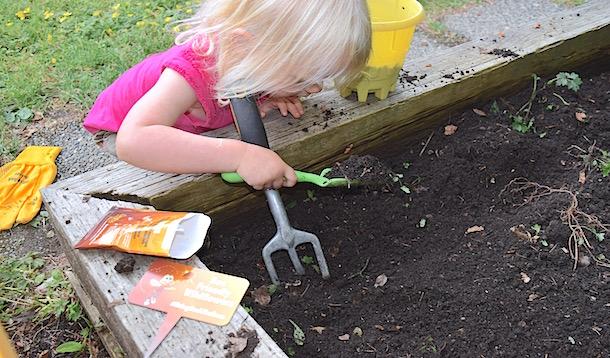
This scene is a common one for parents...you're outside enjoying a beautiful day playing in the sun with your kids when a you hear a blood-curdling scream. The culprit? A bee has flown too close to the action, scaring your little one. Sound familiar? Many kids have some level of apprehension around bees and other insects, but they play such an important role in our lives. Consider this: a whopping 33% of our food is made possible by bee pollination. No bees means saying goodbye to many of your favourite fruits, vegetables, nuts, and even your coffee. You have bees to thank for that morning pick-me-up after the kids have been up all night! Happy Bees = Happy Mama.
With the bee population unstable across North America, involving our families to improve the situation has never been more important. So how can you help your bee-shy munchkins to be more comfortable around their flying neighbours? Try these tips to ease them into the idea:
Knowledge is power, so arm your kids! Show them how to identify the different kinds of bees, and they'll be able to determine which ones - like bumblebees - are very docile, and which ones are more aggressive. Teach them that many bees can't sting at all (males and solitary bees do not sting), and those who can sting, will only do so if afraid or provoked.
Play a game with your children by having them draw all their favourite fruits and vegetables, or go for a walk through your neighbourhood and take pictures of their favourite flowers. Then talk with them about which ones wouldn't grow without the help of the bees. How would their lives (and appetites) be affected if there weren't any bees? Take a look in your fridge and imagine how empty it would be if you took out all of the foods that bees play a part in.
Start small by helping them to not panic the next time an ant crawls on their foot or a fly lands on their shoulder. Some kids are freaked out by any type on insect so this is a good place to start. Don't forget that kids look to adults for behaviour cues, so show them that you're comfortable too!
Wildflowers are an essential part of a bee's natural habitat, and spring is the best time to plant them. Honey Nut Cheerios recently distributed 115 million wildflower seeds to families across Canada through their Bring Back the Bees program to help in creating bee-friendly environments! You can also stop by your nearest garden centre to pick up seeds or plants. Get your kids to help you choose a sunny spot, turn over the ground (clearing any weeds) and sprinkle the seeds! Give the ground a little pat to compress, but don't bury the seeds. Easy-peasy!

A quick Google search will show you where you can go to see bees in action. Hearing an expert talk about how bees work and their importance in our environment, plus seeing them work up close and personally may have a bigger impact on your child.
There are so many fun bee-themed games and activities you can do with your child. Have a picnic outside and only serve foods that bees pollinate or whip up some bee-topped cupcakes! Create bee puppets out of paper bags, socks or construction paper and Popsicle sticks and put on a play about bees. I've included some bee activity printables here to get you started!
![]() #BringBackTheBees Scavenger Hunt
#BringBackTheBees Scavenger Hunt

Some environmental challenges can seem overwhelming, but this one doesn't have to be. The simple act of planting wildflowers and helping your children to be more comfortable around bees is a big contribution to growing and maintaining healthy bee populations. So get everyone involved in working together and having fun while learning the value of environmental stewardship and the importance of bees to human health.
